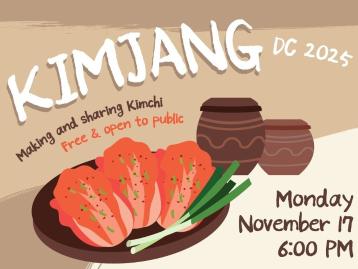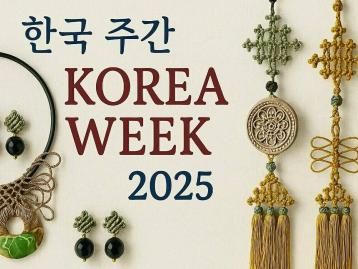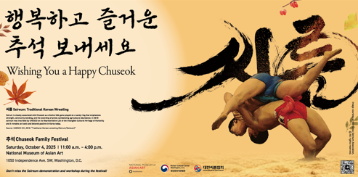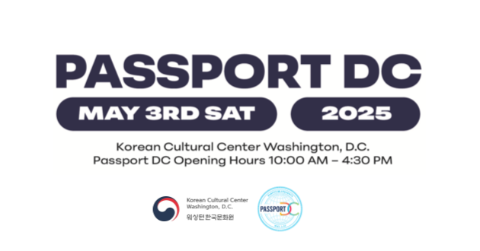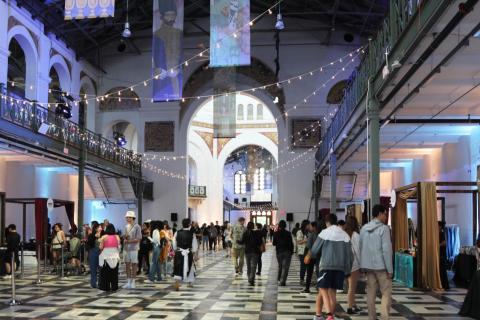EVENTS
-
Kimjang DC 2025: Making & Sharing Kimchi Event Date Nov 17, 2025
Join the Korean Cultural Center Washington, D.C. (KCCDC), the DC Mayor’s Office on Asian and Pacific Islander Affairs (MOAPIA), and chef Ellen Lee of AJM Kimchi for Kimjang DC 2025, a hands-on celebration of Korea’s most beloved culinary tradition—kimjang, the communal making and sharing of kimchi! Community members of all backgrounds are invited to experience the taste, culture, and community spirit that define the kimjang tradition and Korea’s most iconic food, kimchi. Enjoy a live kimchi demonstration with chef Lee, then try your hand at making your own kimchi to take home in a free communal workshop that brings people together. Learn about the history, health benefits, and creativity behind this centuries-old culinary tradition, and celebrate the official Kimchi Day in Korea and the United States by connecting with others through the shared joy of food and culture! 📍 Event Details When: Monday, November 17, 2025, 6:00 p.m. (Doors open at 5:30 p.m.) Where: Martin Luther King Jr. Memorial Library (901 G St. NW, Washington, DC 20001) Admission: Free with an RSVP! RSVP FOP THIS EVENT! Opens Nov. 3 at 9:00 AM About Kimjang A centuries-old tradition, kimjang (김장) often happens once or twice a year in Korea as a way for communities to stock up on essential preserved foods like kimchi (김치), especially before winter. This labor-intensive process is rooted in the tight-knit rural communities of the past, yet the culinary and social bonding benefits of kimjang remain a treasured aspect of Korean culture today. This third annual kimjang partnership between the KCCDC and MOAPIA marks 12 years since the United Nations Educational, Scientific and Cultural Organization (UNESCO) inscribed Kimjang on the Representative List of the Intangible Cultural Heritage of Humanity in 2013. Washington, D.C., Maryland, Viriginia, and several other states also already recognize Kimchi Day on November 22, as does Korea, and the U.S. Congress is considering a similar national designation. About Chef Ellen Lee Ellen Lee is a Washington, DC–based culinary creator and founder of AJM Kimchi, a small-batch kimchi and fermentation brand dedicated to sharing the richness of Korean food culture. Drawing from years of hands-on experience in professional kitchens and community food projects, Ellen focuses on preserving traditional techniques while presenting them in approachable, creative ways. Founded in 2021, AJM Kimchi embodies the spirit of Korean hospitality and craftsmanship through education, collaboration, and sustainability. The name AJM playfully nods to the Korean word “ahjumma”—a term of respect for strong, nurturing women—blended with Ellen’s feline-inspired persona, “Ahjummeow.” The brand’s motto, “Made with Purrpose,” reflects its mission to bring people together through the joy of fermentation, community, and cultural appreciation. For more, follow AJM Kimchi on Instagram. ℹ️ Important Event Information ●Space and supplies are limited. Up to two tickets can be reserved when you RSVP. ●If you follow a vegan diet, please select that specific option when you RSVP. ●RSVP tickets are required for all attendees, and each person must have their own reservation. Complete information for each person must be included for each person for a valid reservation ("guest of" is not sufficient). ●RSVP tickets do not guarantee a seat, and much of the event activity will be while standing. Seating is available on a first-come, first-served basis at the venue. ●Please note that entry may close early once all seats are occupied. Early arrival is recommended. ●Parking is not provided. Guests are kindly asked to use street parking at their convenience, or nearby public lots. A reminder with additional details will be sent before the events date.
Post Date Oct 30, 2025 -
Fall 2025 Korea Week: Crafting Korean Excellence and Celebrating Hangul Event Period Oct 08, 2025 - Oct 11, 2025
The KCCDC is prod to partner with the Liu Institute for Asia and Asian Studies and the Department of East Asian Languages and Cultures to present Korea Week 2025 at the University of Notre Dame, a vibrant celebration of Korean craftsmanship and language, marking the 579th anniversary of Hangul Day (Korean Alphabet Day). Join us for a dynamic week of events showcasing the beauty and excellence of Korean traditional arts and culture—including a live K-pop concert and a K-food truck featuring delicious Korean street food. Experience Korea’s past and present through music, food, art, and language! Korea Week 2025 is co-hosted by the KCCDC with the Liu Institute for Asia and Asian Studies and sponsored by the Department of East Asian Languages and Cultures, the Browning Cinema at the DeBartolo Performing Arts Center, and the St. Joseph County Public Library. For complete details, see the announcement. Fall 2025 Korea Week: Crafting Korean Excellence and Celebrating Hangul October 8 - 11 Liu Institute for Asia and Asian Studies University of Notre Dame 2150 Jenkins Nanovic Halls Notre Dame, Indiana 46556
Post Date Oct 01, 2025 -
2025 Chuseok Family Festival with the National Museum of Asian Art Event Date Oct 04, 2025
Join the Korean Cultural Center Washington, D.C. (KCCDC) and the Smithsonian’s National Museum of Asian Art (NMAA) to celebrate one of Korea’s most important traditional holidays together at the 2025 Chuseok Family Festival on Saturday, October 4! Now in its third year since starting in 2023, the festival has quickly become a signature program for the KCCDC and the NMAA, drawing more than 5,000–6,000 visitors of all ages for a full day of cultural experiences. This year’s highlight include a first-ever introduction and live demonstration of 씨름 (ssireum), Korean traditional wrestling, in Washington, D.C. presented by the Korea Ssireum Association, plus live traditional and K-Pop performances, dance workshops, Korean fashion photo booths, unique cultural heritage displays, and arts and crafts activities. Chuseok (추석), also known as Hangawi (한가위) or more casually as Korean Thanksgiving, is one of Korea's most important and beloved holidays. For many Koreans it is a time to journey home, reconnect with family and loved ones, and to give thanks for life’s blessings. Chuseok traditionally falls on the day of the largest full moon according to the lunar calendar, signaling the end of the harvest season and a time to relax while thanking one’s ancestors for the season’s abundance. For more on Chuseok and its rich traditions, scroll down below. Don’t miss this chance to immerse yourself in the exciting and heartwarming traditions of Korea’s beloved autumn holiday that’s all about family, fun, and connection: Chuseok! Chuseok Family Festival Saturday, October 4, 11:00 AM - 4:00 PM The Smithsonian National Museum of Asian Art 1050 Independence Ave. SW Washington, D.C. MORE INFORMATION & REGISTRATION ON THE NMAA WEBSITE! HIGHLIGHTS Presented by the KCCDC Ssireum: Traditional Korean Wrestling presented by the Korea Ssireum Association Location: Gallery 30, East Building (Arthur M. Sackler Gallery) Photo Display: 11:00 a.m. – 4:00 p.m. Demonstration Matches: 11:00 – 11:20 a.m., 12:30 – 12:50 p.m., 2:30 – 2:50 p.m. Hands-on Workshops:* 11:30 a.m. – 12:30 p.m., 12:50 – 2:00 p.m., 2:50–4:00 p.m. *Workshop particpants will be selected through an on-site raffle and required to sign a safety waiver, per museum regulations. Participation may be limited. K-Pop Music and Activities Location: Freer Plaza (West Building Plaza) Featuring music sets by DJ Taeon Lee, performances and workshops by N2 Studios, and music throughout the day, 11:00 a.m. – 4:00 p.m. Traditional Music & Dance Location: Meyer Auditorium, West Building Korean Traditional Dance & Drumming by Di Dim Sae Korean Traditional Art Institute 1:30 – 2:00 p.m. Presenting Giwonmu (Ritual Dance), Mega Drum Performance, Burna Spin, Hwaraengi Chum (solo dance), and Samgomu (Drum Dance), under Director Soo Kyung Jung Samulnori Traditional Percussion Ensemble by Washington Samulnori 2:10 – 2:40 p.m. Presenting Samdo Sul Changgo Garak and Samdo Nongak Garak, under Director Sebastian Wang Korean Folk & American Old-time Fusion with Global String Band JOOL 3:00 – 3:40 p.m. Featuring Yoona Kim and Sammy Wetstein, and the Korean ajaeng (bowed zither) Cultural Displays & Activities All day 11:00 a.m. – 4:00 p.m. Life Size Charye (차례) Ancestral Rites Table Location: West Building (Freer Gallery of Art), North Corridor Korea Ssireum Association Photo Display Location: East Building (Arthur M. Sackler Gallery), Gallery 30 Crafts, Coloring Activities & Traditional Fan Decorating Location: West Building, South Corridor Hanbok (한복) Traditional Korean Clothing Photo Booth Location: East Building, Gallery 27 (Flex Space) Additional programs presented by the NMAA can be found on their website! This event is co-presented by the Korean Cultural Center Washington, D.C., the Korea Ssireum Association, and the National Museum of Asian Art. Generous support is provided by the National Museum of Korea. ABOUT CHUSEOK Chuseok (추석), also known as Hangawi (한가위) or simply referred to as Korean Thanksgiving, is one of Korea's most important and beloved holidays. For many Koreans it is a time to journey home, reconnect with family and loved ones, and to give thanks for life’s blessings. Traditionally it is on the 15th day of the 8th month of the lunar calendar, which in 2024 falls on September 17. Chuseok literally means “autumn evening” and originates with agricultural society as a celebration of the harvest coinciding with a full moon. The holiday’s other name, Hangawi, also means “great ideas of autumn.” According to the lunar calendar, the largest full moon of the year appears on this day, signaling the end of the harvest season and a time to relax while thanking one’s ancestors for the season’s abundance. Today, many families still gather to share food, games, and fond memories during Chuseok, wherever they live. Many families also maintain the tradition of holding a ritual of thanks with newly harvested crops, expressing their appreciation to their ancestors and to nature itself. Just like Thanksgiving and other harvest festivals worldwide, Chuseok is a blissful time to reconnect and be grateful for all of life’s blessings. As the Korean saying goes, “No more, no less—may it always be perfect like Chuseok” (더도 말고 덜도 말고 한가위만 같아라). In Korea, the day before and after are also typically part of the public holiday, allowing people to travel to their ancestral hometowns and be with family. A traditional Chuseok feast includes an array of treats and delicacies, including half-moon shaped rice cakes known as Songpyeon (송편), deep-fried, honey-soaked wheat confections known as Yakgwa (약과), savory pancakes of meat, fish, or vegetables known as Jeon (전), and herb-infused rice wine known as Baekju (백주) or newly-made rice liquor known as Shindoju (신도주). Chuseok is also often marked by other important cultural traditions. During Charye (차례), the family visits their ancestral gravesite for Seongmyo (성묘), to bow and present a symbolic offering of favorite foods or drink, usually accompanied by Beolcho (벌초), the act of tidying up the gravesites by removing weeds to maintain a cared-for appearance, perhaps while wearing traditional Hanbok (한복) clothing. ABOUT CHARYE (차례) What is Charye? Fundamentally, Charye is a way to remember, thank, and honor one’s ancestors, as well as to invite their continued blessings. Akin to an intimate memorial service or rite, it is often performed in the home during Seollal (Lunar New Year's Day), Chuseok (Korean Thanksgiving Day), and other traditional holidays. The Charye tradition centers around the Charye table; an array of foods are lovingly prepared by family members and displayed on the table, which also serves as a place to pay one’s respects with a formal bow. Traditional holidays in Korea often include merrymaking and family fun, but the presence of the Charye table is a quiet reminder that today’s blessings are made possible thanks to one’s ancestors. Who performs Charye? Charye is a tradition that brings together all members of the family and extended family, each of whom has a chance to briefly offer their respects with a formal bow. Traditionally and when possible, the family's eldest son and his eldest son host the Charye table itself. Where is Charye held? If a family has a dedicated ancestral shrine site, Charye would likely take place there. Otherwise, the Charye table would be set up in the main room of the home. Different families and regions in Korea may have their own Charye traditions. How is Charye held? The constraints and pace of modern life can often impede time-honored traditions, but Koreans will generally make a good faith effort to meet the requirements of a proper Charye as best they can. After all, Charye is as much or more about one’s pure sentiment and good intentions as it is about adhering to protocol. While not an explicitly religious tradition in the Western sense of the word, Charye nonetheless has an important spiritual aspect. Traditionally, one prepares prior to Charye by keeping the mind and body clean for three days. On the morning of, the room housing the Charye table is purified with a brief ritual. Then, under the supervision of the lady of the house, particular foods are prepared for display, including soups, tteok (rice cakes), and jeon (savory pancakes). Meanwhile, male members of the household prepare a written invocation, memorial tablets, ritual vessels, and meat and fruits, all to be included on the table. When it is time to hold the Charye ceremony, the table is carefully set according to tradition with a folding screen behind it. The table also includes a small cup for sul (traditional liquor). Elements of the Chuseok Charye Table Charye tables can vary depending on region and family. However, an important foundational principle is Jinseol, or the proper directional arrangement of dishes according to their essential nature: for example, fish in the east and meat in the west, sweet sikhye drink in the east, and jujubes, chestnuts, pears, and persimmons arrayed from west to east. Some foods will appear in arrangements that contradict traditional Korean dining etiquette, indicating the table’s otherworldly significance. The table often features five rows of food items in total, all of which can take significant time to prepare by hand. The table itself also faces south, so that those taking part can face north. The names of deceased family members are written on traditional Hanji paper and placed at the head of the table just in front of the screen to represent those ancestors’ spirits. Essentials like rice, soup, rice cakes, utensils, and liquor cups are placed in the first row just beyond the inscriptions; while Koreans universally eat with their rice bowls to the left of their soup bowls, here the rice is placed to the right of the soup—the proper position for those in the spirit world. During Chusoek, rice and soup will be replaced with Songpyeon, a traditional filled rice cake that resembles a half-moon. The next row usually features beef and fish dishes, while the third row typically has three soups, each with a different base: beef, seafood, and tofu. The fourth row has dried fish on the left, sikhye at the opposite end, and vegetable side dishes in between. The last row is for sweets like fruit, nuts, and traditional confections; dates, chestnuts, pears, and persimmons are placed in this order from the left. Yakgwa (deep-fried, wheat-based cookies) and hangwa (airy and crunchy rice cookies) are on the right. Interestingly, peaches and red beans are never offered during these ceremonies as they are symbolically used to ward off spirits in other contexts—the opposite of the intention of the Charye table. To learn more about Charye at Korean traditions, visit the National Folk Museum of Korea, the Korean Culture and Information Service, and Korea’s main information website, Korea.net.
Post Date Sep 03, 2025 -
Passport DC: Around the World Embassy Tour 2025 Event Date May 03, 2025
Get ready for DC’s diplomatic party of the year, as the Korean Cultural Center Washington, D.C. and embassies across the city open their doors for Passport DC’s Around the World Embassy Tour on Saturday, May 3 from 10 a.m. to 4:30 p.m.! The Around the World Embassy Tour is a signature cultural event in Washington, D.C., organized by Events DC, during which embassies welcome in the public and introduce their unique cultures through performances, activities, workshops, demonstrations, tastings, and more. The Korean Cultural Center Washington, D.C. is always a must-visit stop on the tour and this year will offer programs for the whole family, including K-Pop cover dance performances, Squid Game experience zones, special exhibition viewings, photo zones, and traditional Korean arts, crafts, and games. Also returning to the stage is the always-incredible Di Dim Sae Korean Traditional Art Institute! Live on-stage performances will feature Konnect DMV and K-Pop dance clubs from American University and Johns Hopkins University. Visitors can also get in on the action and learn iconic K-Pop choreography through interactive workshops with the performers. Drama fans can also learn and compete in family-friendly traditional Korean games inspired by the global hit Netflix series Squid Game, such as jegichagi (Korean hacky sack), gonggi (jacks), and ddakji-chigi (paper tile flipping,or pog). Families and young visitors can also take a break with hands-on crafting activities to create their own coloring art depicting the Korean flag, Korean traditional clothes, and other important symbols of Korea. Passport DC is always free and open to the public, and no RSVP or tickets are required. Lines can get lengthy late in the day though, so come early for the best experience and check out the full schedule below! Passport DC: Around the World Embassy Tour Saturday, May 3, 2025 KCCDC Opening Hours: 10:00 AM – 4:30 PM Main Stage Schedule of Performances ●10:00 AM – Doors Open ●11:00–11:30 AM – K-Pop Dance and Workshop by K-District (American University K-Pop Club) ●12:00–12:30 PM – K-Pop Dance and Workshop by Konnect DMV ●1:00–1:30 PM – K-Pop Dance and Workshop by KPM (Johns Hopkins University K-Pop Club) ●2:30–3:00 PM – DI DIM SAE Korean Traditional Art Institute: Mega Drum and Dance, and more ●3:30–4:00 PM – DI DIM SAE Korean Traditional Art Institute: Mega Drum and Dance, and more Indoor Activities (10:00 AM – 4:30 PM) ●Try traditional Korean games from the Netflix series Squid Game (Jegichagi, Gonggi, Ddakji-chigi) ●Experience Korean traditional instruments (Jing, Kkwaenggwari, Janggu, Buk) ●See the exhibition Unfolding Koreanness (2nd floor) Outdoor Activities (10:00 AM – 4:30 PM) ●Korean DIY crafts (Hanbok & Korean flag coloring, Ddakji making, etc.) ●Write your name in Hangeul (Korean) ●Try on Korean traditional accessories and take a picture at our photo spot ●Take home some free gifts! (K-POP albums, Korean culture magazines, Korean-themed pins)
Post Date Apr 24, 2025 -
Lunar New Year Market: Celebrating Seollal with the National Museum of Asian Art (Feb. 1) Event Date Feb 01, 2025
Celebrate the Lunar New Year and the Year of the Snake in 2025 with the National Museum of Asian Art (NMAA) and the Korean Cultural Center Washington, D.C. (KCCDC)! This year NMAA is hosting an early evening market at the Smithsonian Arts + Industries Building (AIB) where guests can enjoy hands-on activities, lion dances, food, artisans and makers, and more! Special Korean highlights from the KCCDC include displays of traditional Lunar New Year foods, cheongsachorong (청사초롱) lanterns, and bokjumeoni (복주머니) gift pouches, plus special giveaways of K-Pop albums and merch while supplies last! Visitors are also invited to enjoy other non-Korean NMAA cultural activities and family fun at the main museum, 1–3 p.m. Lunar New Year Market Saturday, February 1, 3:00 - 7:00 PM Smithsonian Arts + Industries Building (AIB) Presented by the National Museum of Asian Art (NMAA) in partnership with the KCCDC Visit the NMAA website for a complete schedule of performances, activties, vendors, talks, and more!
Post Date Jan 16, 2025

